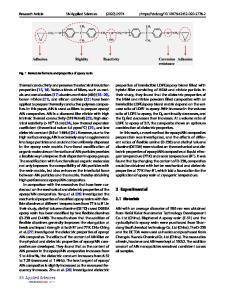Mechanical properties of fiber/graphene epoxy hybrid composites
- PDF / 2,884,893 Bytes
- 7 Pages / 595.22 x 842 pts (A4) Page_size
- 101 Downloads / 380 Views
DOI 10.1007/s12206-020-1016-4
Journal of Mechanical Science and Technology 34 (11) 2020 Original Article DOI 10.1007/s12206-020-1016-4 Keywords: · Composites · Graphene · Tensile strength · Young’s modulus
Correspondence to: Tolga Topkaya [email protected]
Citation: Topkaya, T., Çelik, Y. H., Kilickap, E. (2020). Mechanical properties of fiber/graphene epoxy hybrid composites. Journal of Mechanical Science and Technology 34 (11) (2020) 4589~4595. http://doi.org/10.1007/s12206-020-1016-4
Received November 26th, 2019 Revised
July 23rd, 2020
Accepted August 18th, 2020 † Recommended by Editor Chongdu Cho
Mechanical properties of fiber/graphene epoxy hybrid composites Tolga Topkaya1, Yahya Hışman Çelik1 and Erol Kilickap2 1
2
Department of Mechanical Engineering, Batman University, Batman, Turkey, Department of Mechanical Engineering, Dicle University, Diyarbakır, Turkey
Abstract
The aim of this study is to determine the effect of graphene nanoparticle (GNP) reinforcement on the mechanical properties of glass fiber reinforced polymer (GFRP), carbon fiber reinforced polymer (CFRP) and aramid fiber reinforced polymer (AFRP) composites commonly used in the space and defense industry. Accordingly, GFRP, CFRP and AFRP composites were produced by using hot pressing method. In addition, hybrid fiber composites were produced by adding 0.1 %, 0.2 % and 0.3 % GNP to these fiber reinforced composites. The tensile strength and modulus of elasticity of the composites were determined. The tensile damage fracture regions were analyzed by scanning electron microscopy (SEM) and energy distribution spectrum (EDS). It was observed that the addition of 0.2 wt. % GNP to GFRP and CFRP composites increased tensile strength and modulus of elasticity. However, the addition of 0.2 wt. % GNP to AFRP composites had no effect on the tensile strength; on the contrary, it partially reduced the tensile strength but increased the modulus of elasticity. On the fracture damage surfaces of the GFRP and CFRP composites and the GNP/GFRP and GNP/CFRP hybrid composites, the fibers were completely separated. On the damage surfaces of AFRP composite and GNP/AFRP hybrid composites, the fibers were deformed but these fibers were not separated from each other. From the EDS analysis, it was observed that the element C increased in the composites with the addition of GNP to the fiber reinforced composites.
1. Introduction
© The Korean Society of Mechanical Engineers and Springer-Verlag GmbH Germany, part of Springer Nature 2020
Scientists and engineers are looking for lighter and more durable materials than existing materials due to environmental concerns. Particularly in industries such as aerospace and automotive, materials with low weight and high mechanical properties are needed to reduce fuel consumption and carbon emissions. Composite materials can be used for this purpose. By using composite materials such as GFRP and CFRP, approximately 1 million liters of fuel can be saved from single aircraft every 5 years [1]. When the weight of an
Data Loading...











